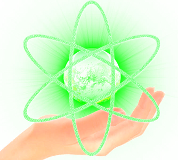G. Albertini · V. Calbucci · F. Cardone · A. Petrucci · F. Ridolfi
Abstract
The focus of this work is a careful chemical investigation of structural damage produced by the exposure of an iron bar to pressure waves generated using an ultrasound machine (called the R-1-S reactor). In addition to the emission of neutron bursts, the ultrasound treatment caused the appearance of zones of macroscopic damage (∼1 mm in size) on the exterior of the bar.
Reflected-light optical and environmental scanning electron microscopy (ESEM) has shown that these external damage zones are characterized by microcraters and are covered by a thin layer of cracked amorphous material. Under back scattered electron (BSE) observation, this material shows a lower brightness than the intact ferrite surface. In addition, a zone with a high density of deformed cavities (∼1300 per mm2 ) with irregular walls and a maximum size of 10 μm was found inside the bar. These deformed microcavities are partially filled with a material composed of a chaotic assemblage of submicron-sized (most likely amorphous) particles.
A careful compositional investigation of the chaotic material inside the microcavities using the semi-quantitative data obtained with the ESEM X-ray Energy Dispersive System (EDS) has shown that it is primarily composed of carbon, manganese and chromium. These elements are also found in lower amounts within the intact ferrite matrix.
In contrast, the damaged surface surrounding the craters is characterized by elements not found in the ferrite at all (i.e., O, Cl, K, Cu); elements the presence of which cannot be attributed to the occurrence of non-metallic inclusions or to contamination during fabrication.
These results are also difficult to explain using the generally accepted laws of physics; however, they do appear to agree with a recent theory predicting the deformation of the local spacetime and the violation of the Local Lorentz Invariance. Such a violation should occur following the collapse of micron-sized discontinuities internal to the materials (micropores) exposed to ultrasonic pressure waves resulting in an energy density to time ratio large enough to overcome the threshold predicted by the deformed space-time theory, triggering, in this way, a new kind of nuclear reaction. Following this theory, the C-, Mn- and Cr-rich chaotic material inside the microcavities is the product of the spherically symmetrical collapse of micropores internal to the ferrite while the presence of new elements within the cratered damage zones on the ferrite surface can be attributed to the catastrophic collapse of the subsurface pore walls resulting from microexplosions.
Appl Phys A (2014) 114:1233–1246 DOI 10.1007/s00339-013-7876-z
Link: http://link.springer.com/article/10.1007/s00339-013-7876-z








